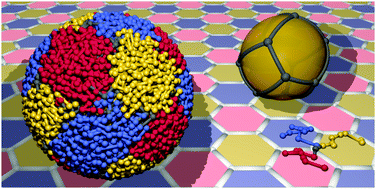Patchy particles by self-assembly of star copolymers on a spherical substrate: Thomson solutions in a geometric problem with a color constraint†
Abstract
Confinement or geometric frustration is known to alter the structure of soft matter, including copolymeric melts, and can consequently be used to tune structure and properties. Here we investigate the self-assembly of ABC and ABB 3-miktoarm star copolymers confined to a spherical shell using coarse-grained dissipative particle dynamics simulations. In bulk and flat geometries the ABC stars form hexagonal tilings, but this is topologically prohibited in a spherical geometry which normally is alleviated by forming pentagonal tiles. However, the molecular architecture of the ABC stars implies an additional ‘color constraint’ which only allows even tilings (where all polygons have an even number of edges) and we study the effect of these simultaneous constraints. We find that both ABC and ABB systems form spherical tiling patterns, the type of which depends on the radius of the spherical substrate. For small spherical substrates, all solutions correspond to patterns solving the Thomson problem of placing mobile repulsive electric charges on a sphere. In ABC systems we find three coexisting, possibly different tilings, one in each color, each of them solving the Thomson problem simultaneously. For all except the smallest substrates, we find competing solutions with seemingly degenerate free energies that occur with different probabilities. Statistically, an observer who is blind to the differences between B and C can tell from the structure of the A domains if the system is an ABC or an ABB star copolymer system.



 Please wait while we load your content...
Please wait while we load your content...